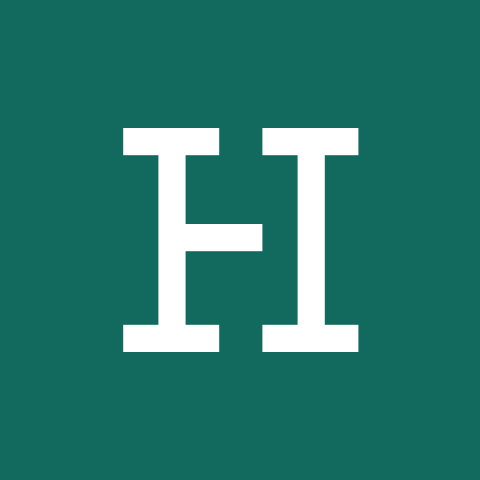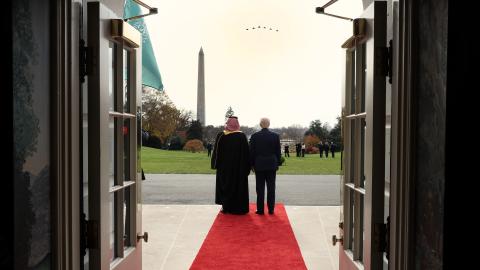President Donald Trump’s announcement that the United States will sell F-35 combat aircraft to the Kingdom of Saudi Arabia is a turning point for airpower dynamics in the Middle East, with broad geopolitical implications.
The Lockheed Martin F-35, a fifth-generation, multirole stealth aircraft with unrivaled information superiority features, represents the leading edge of American tactical military aviation. Its high-end capabilities, from providing deep battlespace awareness to enabling distributed, networked precision strikes in nonpermissive airspace, make it one of the rare assets that can single-handedly alter the outcome of a conflict.
The announcement that Saudi Arabia will be the first Arab nation to procure this system has severe implications for three key pillars of American engagement in the Middle East:
- Outcompeting China in the quest for long-term influence over the region’s militaries and weapons markets.
- Boosting the capabilities of Washington’s Gulf Arab partners to counter Iran.
- Preserving Israel’s qualitative military edge (QME) in a worsening threat landscape.
Geopolitical Importance: Preventing the Saudis from Hedging toward China
President Trump’s announcement, made on the eve of Crown Prince Mohammed bin Salman’s White House visit, is an important step for preventing Saudi Arabia from drifting further into China’s military orbit. The sale likely cleared a Pentagon review in advance of the president’s meeting with the de facto Saudi monarch. If it goes through, Saudi Arabia will acquire 48 F-35s, making it the first Arab nation to operate a fifth-generation combat aircraft.
The United States Defense Intelligence Agency reportedly warned Trump administration officials that, because of Riyadh’s defense partnership with Beijing, selling the F-35 to Saudi Arabia might give China access to the aircraft’s critical technologies. Nonetheless, Saudi Arabia’s increasing ties with China were likely a key reason why President Trump decided to go through with the sale. Riyadh has signaled that it will not depend solely on the United States for its security—and that if Washington hesitates, the kingdom will pursue other avenues. Moreover, Riyadh’s recent strategic mutual defense agreement with Pakistan—a China-aligned Muslim-majority nation with a capable military and nuclear assets—sent an unmistakable message to the US about the House of Saud’s leverage.
Beijing has been deeply involved in supplying the kingdom with armaments, especially missile and drone warfare assets, for at least a decade. Geospatial analysis shows that Saudi Arabia has significantly expanded the Royal Saudi Strategic Missile Force in recent years while also seeking to expand its indigenous defense industrial base. The crown prince has also pressed for local production agreements as a condition of major defense acquisitions—especially missile programs. Saudi Arabia now has a solid-propellant motor production line at the al-Watah ballistic missile base, and US intelligence assesses that Riyadh is manufacturing an undisclosed slate of ballistic missiles with direct Chinese assistance.
For many countries, ballistic missile cooperation with China would end any hope of close military ties with the US—let alone an F-35 acquisition. But whenever Washington withholds a capability that Riyadh views as vital, the kingdom hedges further toward Beijing. When America withheld Pershing ballistic missiles from Riyadh in the 1980s, the Saudis sought DF-3 missiles from China. The eventual $3.5 billion deal between Riyadh and Beijing was the start of a pattern that endures today. It is therefore likely that the Trump administration believed that the crown prince’s major ask was more than mere posturing.
Beijing has publicly signaled that its ostensible fifth-generation competitor to the F-35, the J-20 stealth fighter, remains under strict export restrictions. But the strategic situation is fluid. If China’s leadership sees a chance to score a strategic victory over the United States, those export barriers could quickly fall. The United Arab Emirates—another Gulf state that Washington has thus far shut out from F-35 procurement over concerns about Chinese defense technology espionage through local Huawei 5G infrastructure—has reportedly shown interest in the J-20. If the right opportunity to erode US aerospace dominance in the Gulf presents itself, Beijing may decide to seize it.
Fortunately for the White House, providing Riyadh with the F-35 might serve multiple US strategic interests—if the political-military perspective holds and the diplomatic stars line up. As mentioned, it boosts America’s position as it competes with China for regional influence. F-35s would be an effective but American-dependent asset for the Saudis to operate. Second, Washington needs capable Gulf partners that can plug seamlessly into the US military’s regional architecture to help counter Iran. This architecture became even more critical when the US officially moved Israel from the European Command (EUCOM) area of responsibility to Central Command (CENTCOM) in 2021. Having an allied F-35 detachment in the Gulf would allow CENTCOM to respond even more forcefully to future Iranian aggression, enhancing deterrence. Finally, Saudi Arabia, sitting at the nexus of the Red Sea and the Gulf, is a valuable geopolitical partner. Its critical role in global energy markets and its fast-growing portfolio of high-tech and defense industrial investments under its Vision 2030 further increase its importance. Militarily, the kingdom remains one of the few states capable of hosting large-scale US detachments to anchor American deterrence against Iran.
The Trump administration’s decision to sell the F-35 to Saudi Arabia reveals the strategic trust Washington is willing to extend to its longtime ally—and reinforces the alignment it expects from Riyadh in return. In the White House’s calculus, this deal benefits the US and its Saudi allies while harming China.
Stealth in the Gulf: The Potential Military Transformation behind Fifth-Gen Air Superiority
Saudi Arabia, thanks to its considerable wealth, is already one of the world’s top defense spenders. Between 2020 and 2024, the kingdom ranked fourth among the world’s arms importers and was the primary Middle Eastern recipient of US-made munitions. But Riyadh has, for years, viewed the acquisition of a fifth-generation combat aircraft as the capstone of its Vision 2030 defense transformation agenda—an ambitious program to rapidly advance its military capabilities.
The stealth-equipped F-35 is the backbone of the North Atlantic Treaty Organization’s tactical aviation deterrent. According to Lockheed Martin, more than 600 F-35s will be stationed across NATO air bases in Europe by the 2030s. For reference, the French military has ordered just 234 of its indigenous Dassault Rafale combat aircraft as of November 2025. Beyond Europe, the F-35I has given the Israeli Air Force operational freedom in hostile Middle Eastern skies.
The F-35’s stealth and information superiority capabilities would dramatically shift the Saudi-Iranian balance of power. The aircraft’s ability to operate deep in nonpermissive airspace and overcome layered air defense architectures would allow Saudi Arabia to threaten the Islamic Revolutionary Guard Corps’ missile sites, drone nests, command hubs, and other critical infrastructure.
Moreover, the F-35 would serve as a force multiplier, enhancing the effectiveness of the rest of the kingdom’s air warfare posture. Fifth-generation platforms like the F-35 operate within smart battle networks, or systems of systems. In Israel’s recent 12-day war with Iran, F-35Is played a central role in the Israeli Air Force’s strike packages. The fifth-generation aircraft’s advanced computational systems and data fusion capabilities enhanced Israeli forces’ real-time awareness. Its high-end sensors, including the AN/AAQ-37 Distributed Aperture System and the AN/APG-81 active electronically scanned array (AESA) radar, fed continuous targeting and threat information to fourth-generation F-15Is and F-16Is, supercharging their lethality and survivability. The F-35 would offer a similar boost to the Saudi Royal Air Force’s F-15s, giving Riyadh access to a realm of operational concepts that is unique among Arab militaries.
The Shifting Regional Balance: Saudi Ambitions Encroach on Israel’s Qualitative Military Edge
No Arab state has ever operated a platform that rivals, let alone matches, Israel’s prime air warfare asset. This is no accident. Israel has long insisted on maintaining its QME, undergirded by a US policy commitment to ensure the Israeli military’s regional superiority.
The Israeli strategic community is now wondering whether Washington will end Israel’s long-standing regional monopoly on stealth technology, or whether the Trump administration will give the Israeli Defense Forces a new, decisive warfighting advantage.
Israeli planners have seen this dynamic play out before. When Washington agreed to transfer F-15s and airborne early warning and control system (AWACS) aircraft to Saudi Arabia in the 1980s, Israeli diplomatic efforts convinced the Reagan administration to restrict the supplies Riyadh received. Washington thus withheld its most advanced jamming configurations and forbade Saudi AWACS aircraft from flying outside the nation’s borders. The Trump administration could place similar technical and operational limits on the F-35s it sells to Riyadh.
Yet even if Saudi Arabia receives fully capable F-35s, Israel’s advantage would not disappear overnight. Israel’s unmatched combat experience flying F-35s in hostile airspace and the modifications unique to the Israeli F-35I Adir, including its indigenous electronic warfare suite, would help the Israeli Air Force retain its edge.
Nonetheless, a strategic calculus will likely inform Israel’s response to the Saudi F-35 acquisition. Rather than citing the QME policy to oppose Riyadh’s fifth-generation airpower ambitions, the Israeli government will likely press Washington to make a normalization of Saudi-Israeli diplomatic relations a precondition of the F-35 sale.
Conclusion
The Trump administration’s decision to supply Saudi Arabia with F-35s could reshape airpower in the Middle East for a generation. A fifth-generation fleet in the kingdom could enhance deterrence against Iran, strengthen the US-led regional coalition, and anchor the US—rather than China—as Saudi Arabia’s main defense industrial partner.
Yet the move also challenges Israel’s long-standing stealth exclusivity and the long-standing QME framework. Israel’s position on the Saudi acquisition of the F-35—conditional openness tied to normalization of relations—reflects a recognition that outright rejection is no longer politically or militarily sustainable. But the Israeli defense establishment nonetheless realizes that safeguards, restrictions, and political reciprocity will best serve its qualitative edge privileges and strategic interests.
For the United States, the choice is clear. Anchoring Riyadh in the US-led security architecture by delivering a carefully designed F-35 deal that preserves Israel’s QME advances US military and economic interests and regional stability. On the other hand, if the White House balks at the deal, it risks ceding strategic ground to Beijing in the Gulf’s most strategically vital market.
How the Trump administration navigates this deal will be a key test of US statecraft in the Middle East, with major implications for great power competition against China. The sale of F-35s to Saudi Arabia is fraught with risks—but charged with massive upside.




















